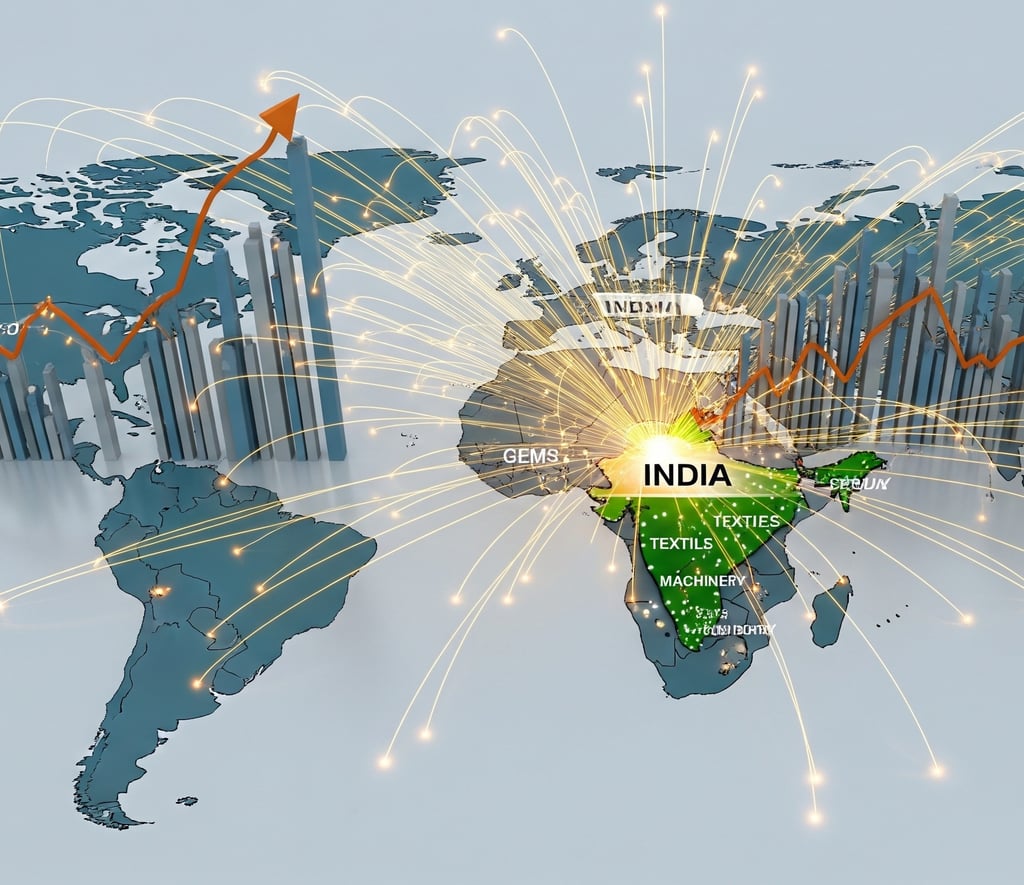A Deep Dive into India's Export Performance in 2023-2024
A recent analysis of export data for the fiscal year 2023-2024 reveals a fascinating story of resilience, strategic shifts, and new opportunities. While traditional partners remain crucial, emerging growth drivers and the ever-present challenge of trade imbalances are shaping the future of 'Made in India' goods on the world stage.
INTERNATIONAL TRADETRADE TRENDSUSATRADE DEALS
7/21/20253 min read


A Deep Dive into India's Export Performance in 2023-2024
In the complex theatre of global trade, India continues to carve out its position as a major exporting powerhouse. A recent analysis of export data for the fiscal year 2023-2024 reveals a fascinating story of resilience, strategic shifts, and new opportunities. While traditional partners remain crucial, emerging growth drivers and the ever-present challenge of trade imbalances are shaping the future of 'Made in India' goods on the world stage.
Let's break down the key takeaways from the latest trade figures.
The Stalwarts: USA and UAE Remain Top Destinations
The United States continues its reign as India's single largest export market, with goods worth approximately $78.5 billion shipped in 2023-2024. This accounts for a significant 16.8% of India's total exports. Following closely is the United Arab Emirates (UAE), which imported $35.6 billion worth of Indian goods.
However, the data reveals a slight cooling-off period with these top partners:
USA: Exports saw a decline of −3.3%.
UAE: Exports dipped by −0.4%.
Despite these modest dips, which could be attributed to global economic headwinds, India maintains a very healthy trade surplus with the US, amounting to over $36.7 billion. This underscores a strong, mutually beneficial trade relationship.
New Growth Engines: Europe and the Middle East Show Strong Momentum
While some traditional markets consolidate, several other nations have emerged as powerful growth engines for Indian exports. This diversification is a sign of a robust and adaptable export strategy.
The standout performers include:
United Kingdom: Exports surged by an impressive 15%, making it a key growth market. With a trade surplus of over $3.4 billion, the potential future of an India-UK Free Trade Agreement (FTA) could unlock even greater value.
France: Showing remarkable growth, exports to France increased by 14%.
Saudi Arabia: Bucking the trend of its neighbours, imports from India grew by 9.6%.
Russian Federation: An outlier with an astronomical 20% growth, likely influenced by shifting geopolitical and energy dynamics.
These figures highlight a strategic pivot, with Indian exporters successfully tapping into new and expanding markets, particularly in Europe.
The Balancing Act: The Story of Surpluses and Deficits
A nation's trade balance is a critical indicator of its economic health. The data paints a picture of two halves.
Key Trade Surpluses (Where India Exports More Than It Imports):
USA: +$36.7 billion
Netherlands: +$15.8 billion
United Kingdom: +$3.4 billion
Bangladesh: +$13.8 billion
Key Trade Deficits (Where India Imports More Than It Exports):
China: −$48.0 billion
Russian Federation: −$44.0 billion
Switzerland: −$20.5 billion
Saudi Arabia: −$18.6 billion
The significant deficit with China remains a long-term economic challenge. The growing deficit with Russia is a more recent development, primarily driven by India's increased energy imports.
Tariffs and Market Access
The data also provides a glimpse into the trade barriers Indian goods face. The average tariff faced by India is remarkably low in many key markets, such as the UAE (0.00%) and Hong Kong (0.02%). This facilitates smoother trade. However, in other regions, like Bangladesh (12.7%) and Brazil (10.2%), higher tariffs present a challenge that ongoing trade negotiations aim to address.
The Road Ahead
The 2023-2024 export data tells a story of a dynamic and evolving strategy. While facing a slight downturn in its biggest markets, India is successfully diversifying its export basket and finding strong growth in Europe and parts of the Middle East.
The key to future success will lie in:
Strengthening ties with high-growth partners.
Strategic negotiations through FTAs to reduce tariffs and improve market access.
Addressing the trade imbalance, particularly with key partners like China, by boosting domestic manufacturing and high-value exports.
As the global economic plates continue to shift, India's ability to remain agile, competitive, and strategic will determine its trajectory as a leading force in international trade.

Astan Finserv Consultancy Services
Export Consultation, Export and Customs Documentation, Duty drawback and Indian Govt Export Schemes and Export Trainings.
© 2025. All rights reserved.